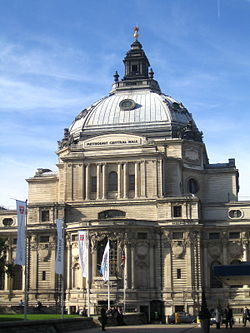UK Gay Liberation Front 1971 Festival of Light action
| UK Gay Liberation Front 1971 Festival of Light action | |||
|---|---|---|---|
| Part of Gay liberation movement | |||
 | |||
| Date | 9 September 1971 | ||
| Location | 51°30′00″N 0°07′48″W / 51.50000°N 0.13000°W | ||
| Parties | |||
| Lead figures | |||
On 9 September 1971 the UK Gay Liberation Front (GLF) undertook an action to disrupt the launch of the Church-based morality campaign Nationwide Festival of Light at the Methodist Central Hall, Westminster.[1] A number of well-known British figures were involved in the disrupted rally, and the action involved the use of "radical drag" drawing on the Stonewall riots and subsequent GLF actions in the US. Peter Tatchell, gay human rights campaigner, was involved in the action which was one of a series which influenced the development of gay activism in the UK, received media attention at the time, and is still discussed by some of those involved.[2]
Background
The
The Festival of Light included several notable people of that time, such as
Activism as theatre

Drawing on the gay tradition of camp, GLF developed a new style of political campaigning, "protest as performance", where the claim for human rights was projected through creativity, using imagination, daring and wit, rather than marches and rallies.
Peter Tatchell described the Festival of Light as being against the "moral darkness" of "pornography, homosexuality and abortion." The GLF counter-protest was code-named "Operation Rupert' after the subversive 'Rupert Bear' cartoon in OZ magazine. He attended the Festival action as part of the GLF Youth Group. "When Malcolm Muggeridge, speaking out about homosexuals, declared: 'I don't like them.' The feeling was mutual,"[2] the group he was part of staged a "kiss-in" in the upper balcony of the hall. "Mice were released into the audience; lesbian couples stood up and passionately embraced. A dozen GLF nuns in immaculate blue and white habits charged the platform shouting gay liberation slogans, and a GLF bishop began preaching an impromptu sermon which urged people to 'keep on sinning.'"[2]
Radical Drag
The theme known as "radical drag" was a central element to the Festival of Light and subsequent GLF actions. In response to ideas about the 'wrong-sex', gay people distanced themselves from stereotypes of effeminate gay men and
Subsequent campaigns and other actions
The work of GLF in this and other actions and demonstrations helped inspire more people towards open activism. Following the style of campaign and public demonstration, CHE changed its own style of campaigning, and interest in GLF waned. After the demise of GLF,
Other actions and acts of civil disobedience confronting discrimination and homophobia at the time included a picket at
See also
- Gay liberation
- Socialism and LGBT rights
- Gay Activists Alliance
- USA GLF: N. A. Diaman, Brenda Howard, Sylvia Rivera
- London GLF: Bob Mellors, Peter Tatchell
- Hall–Carpenter Archives
- List of LGBT rights organizations
- Nationwide Festival of Light
References and further reading
- Material relating to the Festival of Light, [1971–1975], mainly concerning the disinformation campaign by the GLF, is held at the Hall–Carpenter Archives.[9]
- "Today in London religious history, 1971: the Gay Liberation Front mash up reactionary christian Festival of Light". Past Tense: London radical histories and possibilities. 9 September 2019. Retrieved 22 May 2021.
- ISBN 978-0-304-33195-6.
- Whipple, Amy C. (13 July 2010). "Speaking for Whom? The 1971 Festival of Light and the Search for the 'Silent Majority'". S2CID 144839277.
Footnotes
- ^ "Gay Liberation Front (GLF)". Database of Archives of Non-Government Organisations. University of Birmingham.
- ^ a b c Tatchell, Peter. "Idealism, Pride & Anger — The Beginnings Of Lesbian and Gay Liberation in Britain".
- ^ a b "Overview of Lesbian and Gay History" (PDF). Fife Men Project.
- ^ a b "Obituary: MARTIN ROGER CORBETT: Queer Activist and Saint, 27-November-1944 – 11-July-1996". OutRage!. 13 July 1999.
- ^ a b c Smith, Rupert (27 May 2008). "'Bette Bourne: interview". Time Out.
- ^ Hodges, Andrew; Hutter, David (1974), The Gay Liberation pamphlet: With Downcast Gays, section 5
- ^ Walker, Shaun (23 October 2011). "Riot police arrest Tatchell at gay march in Moscow". The Independent.
- ^ a b Tatchell, Peter (24 November 1995), "Memories of the London Gay Liberation Front", Pink Paper
- ^ "British Library of Political and Economic Science: Gay Liberation Front". Archived from the original on 3 March 2016. Retrieved 19 May 2009.
